 You can’t beat self-employment.
You can’t beat self-employment.
Working from home.
Working in your pajamas.
Working your own schedule.
Working the way you want to.
No commute.
No office politics.
No pointless meetings.
No bosses breathing down your neck.
Sounds like a dream job, right?
Well, it is. Most of the time.
EXCEPT FOR ONE PROBLEM: You’re the only person who can hold yourself accountable.
And if you don’t hold your own feet to the fire – eventually they’re going to freeze.
And frozen feet don’t make money.
This is about discipline.
This is about self-motivation.
This is about commitment to consistent action.
Whether you work at home, work by yourself or work in an independent role, consider these ideas to make sure you motivate yourself to execute what matters:1. Shake hands with yourself. Somewhere down the line, you’ve had manager, boss or supervisor – that you wanted to strangle with an orange extension cord. And my guess is: You weren’t especially motivated by their words, right?
Lesson learned: People rarely remain accountable to people they hate.
If you plan to be the person holding your own feet to the fire, the first key is simple: You better like yourself. Otherwise it’s going to be extremely hard to listen. And if you think that sounds corny, you’re right – it is. But corny doesn’t mean ineffective.
The second key is to establish expectational clarity with yourself. After all, the enemy of accountability is ambiguity. And a flawed assumption about yourself can set the whole process in misdirected motion.
The final key is to isolate your why. To assess your own motives. Because when you know why something is important to you, you never fail to impose the accountability required to execute it. What kind of relationship do you want to have with yourself?
2. Ask yourself focus questions. If what you’re doing – right now – is not consistent with your number one goal, you lose. Keep asking yourself if it is. And if what you’re doing right now isn’t supporting your own strategic intent, you lose. Keep asking yourself if it is.
This process of self-questioning is the single most effective strategy for self-accountability. It’s confrontational, it’s creative and it’s guaranteed to give you a much-needed kick in the ass.
As long as you don’t forget: Motivation without execution is nothing but consuming empty calories. Like eating seven pounds of iceberg lettuce and a Diet Coke. Blech.
Instead, commit to clothing your resolutions in concrete actions. Are you honest with yourself about what really motivates you?
3. Paint yourself into an accountable corner. When I first started my publishing company, I was still living in my parents’ basement. Not exactly an environment conducive to productivity and professionalism.
Ever try to make a sales call to a Fortune 500 company when your mother is screaming from upstairs to find out if you want broccoli or asparagus with your salmon?
Yikes. That’s why I made the commitment to leave the house every morning at 6AM, dressed and ready to go to work. But I didn’t go to an office; I went to a coffee shop. Just to have somewhere to go. Just to get into the right mindset.
And I’d spend the next two hours reading, relaxing, journaling and prepping my day. The cool part was, I’d see the same people each morning. And if I got lazy and slept in, they’d always ask, “Scott, what happened yesterday? We missed you!”
Over a period of two years, this daily commitment sharpened my discipline and laid a foundation of self-accountability that became essential in my career.
I don’t go to the coffee shop anymore, but I still start work at five. Sometimes four. It’s hardwired into me. What ritual will you build into your daily schedule to convince yourself that you actually have a real job?
4. Design your ideal day. If you don’t impose (some) structure into your otherwise chaotic schedule, the entrepreneurial undertow will carry you out to the sharks.
And when I say sharks, I’m referring to the chorus of meaningless distraction, seductive attention magnets and other ruthless villains of your time. Your challenge is to introduce enough structure to fight that undertow.
After all: Routine is healthy. Routine prevents insanity. Routine curtails procrastination. What’s more, ritualizing your days prevents you from saying, “Why the hell am I doing this?”
Without such structure, you wind up (artfully) creating constant distraction that prevents you from seeing the pointlessness of your activity.
On the other hand, I’m not a proponent of over scheduling.
I’ve been guilty of this in the past. Ruthlessly regimenting every minute of your day might keep you accountable to yourself, but it also might cause an ulcer. Your challenge is learning balance structure with spontaneity. What’s a typical day like for you?
5. Establish metrics that matter. While facilitating a recent leadership retreat, one of my participants said – and I quote – “The other day I cut the grass just to feel like I did something.”
Good lord. But, I guess good for him for executing that task. Too bad that task didn’t matter. That’s the rub with self-accountability: If you’re going to kick your own ass, you better wear a relevant shoe. Otherwise you wind up executing – exquisitely – something inconsequential.
Consider this: First, establish weekly criticals. These are the five key tasks that absolutely need to be executed by the end of the week for that week to be considered a success. Otherwise you’ve just wasted seven days of your life.
Second, develop daily essentials. These are the three highly valuable activities that absolutely need to be accomplished for that day to be considered a success. Ultimately, the effectiveness of this practice comes from the small-scale, non-threatening nature of the metrics.
What’s more, if you focus on small wins, the larger victories will happen by themselves. I’ve been logging these two metrics daily for eight years. It works. Are you winning a game that (actually) matters?
6. Create a nonstick surface. When you used to bake cookies with your mother, what was the first step in the process? Right: Dust the counter with flour. Why? So the dough didn’t stick.
Same thing goes with self-accountability. If you want to avoid getting stuck in trap of self-employed sluggishness, you need to take measures to create a nonstick surface.
My suggestion is to take short breaks every ninety minutes. This helps your body and mind refuel. Especially if, during your break, you go perpendicular to the task at hand.
For example, to break from writing, I pick up my guitar. Why? Because after eighteen years of playing music, I don’t have to think anymore. I just start jamming.
And when your occupation is to think for a living, nothing could be healthier for keeping your schedule on task than to give your break a break. Are you punctuating your day to unstick yourself?
7. Don’t beat yourself up when you fall short. Just because you’re self-employed doesn’t mean you’re not human. (Except for a few of my robot friends, but they’re probably not reading anyway. Lazy punks.)
Anyway, in your quest to stay accountable to yourself, recognize that you will miss the mark from time to time. Learn to be okay with that. As my yoga instructor constantly reminds us:
“Try not to pass judgment on yourself. When you interrupt stillness or fall out of posture, just notice it.”
Try this: Next time resistance gets the best of you – let’s say you unexpectedly oversleep till ten on a Tuesday – use that moment as a bell of awareness to send vibrations of self-accountability through your bones.
Instead of smashing your head into the maple bedpost telling yourself how much of a worthless, lazy excuse for an entrepreneur you are, brainstorm how you might be able to recoup that missed time later in the day or week.
Could you have a working lunch? Could you read while you exercise? Could you catch up after dinner instead of watching the three-hour finale of “So You Think You Can Dance?”
Look. Don’t be so hard on yourself. It happens. Will you be kind to yourself when you fall short?
8. You are the result of yourself. That’s the thorny, self-confrontational reality of self-employment: If you don’t do what you told yourself you were going to do, the only person around to notice, is you.
Which means there’s nobody to blame. Which means the onus is, was, and always will be, on you. Because even if you work alone, even if you spend every day sitting in your living room wearing your pajamas, you’re always in a relationship with yourself.
You still have to sleep with who you are, every night. Don’t create a reputation for unreliability. As Sir Josiah Stamp once wrote, “It is easy to dodge our responsibilities, but we cannot dodge the consequences of dodging our responsibilities.”
Ultimately, assuming success is somebody else’s fault is the hallmark of an immature mind. And immaturity pollutes practically all behavior. Never forget that you are sole source of your own job security. Have you allowed yourself to fully and confidently face your own responsibility for your career?
REMEMBER: The long-term survivability of your business is dependent on your ability to kick your own ass.
Yes, laziness becomes extremely attractive when you know the masses will never know the difference.
But as an entrepreneur, holding your own feet to the fire is part of the job description.
So, stay committed to being committed.
Because sometimes, you have to administer the medicine to yourself, no matter how bad it tastes.
LET ME ASK YA THIS…
Are you willing to open wide and swallow the syrup of self-accountability?
LET ME SUGGEST THIS…
For the list called, “61 Things to Stop Doing Before It’s Too Late,” send an email to me, and I’ll send you the list for free!
* * * *
Scott Ginsberg
That Guy with the Nametag
Author, Speaker, Entrepreneur, Mentor
[email protected]
 Never the same speech twice.
Never the same speech twice.
Always about approachability.
Watch The Nametag Guy in action here!
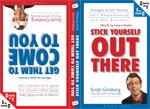 The world’s FIRST two-in-one, flip-flop book!
The world’s FIRST two-in-one, flip-flop book!
 You can’t beat self-employment.
You can’t beat self-employment.
 “My life is my preparation.”
“My life is my preparation.”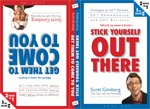 The world’s FIRST two-in-one, flip-flop book!
The world’s FIRST two-in-one, flip-flop book! And now for a few words from some dead white guys:
And now for a few words from some dead white guys: Six hours from now, I’ll be taking center stage here in Denver for the Optimist International Convention.
Six hours from now, I’ll be taking center stage here in Denver for the Optimist International Convention.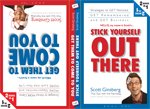 The world’s FIRST two-in-one, flip-flop book!
The world’s FIRST two-in-one, flip-flop book! I’m aware of the irony of publishing a list of instructions on how not to conform.
I’m aware of the irony of publishing a list of instructions on how not to conform. “Nobody’s reading your blog because of your art. They’re reading your blog because the person you are inspires them. They’re not reading your blog because they’re thinking of buying your paintings, they’re reading your blog because the way you approach your work inspires them. It sets an example for them. It stands for something that resonates with them. It leads them to somewhere that they also want to go.”
“Nobody’s reading your blog because of your art. They’re reading your blog because the person you are inspires them. They’re not reading your blog because they’re thinking of buying your paintings, they’re reading your blog because the way you approach your work inspires them. It sets an example for them. It stands for something that resonates with them. It leads them to somewhere that they also want to go.”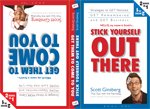 The world’s FIRST two-in-one, flip-flop book!
The world’s FIRST two-in-one, flip-flop book! It’s great to have people cheering for you.
It’s great to have people cheering for you.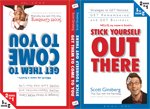 The world’s FIRST two-in-one, flip-flop book!
The world’s FIRST two-in-one, flip-flop book! The world’s FIRST two-in-one, flip-flop book!
The world’s FIRST two-in-one, flip-flop book! Public schools should teach evolution.
Public schools should teach evolution. The world’s FIRST two-in-one, flip-flop book!
The world’s FIRST two-in-one, flip-flop book!